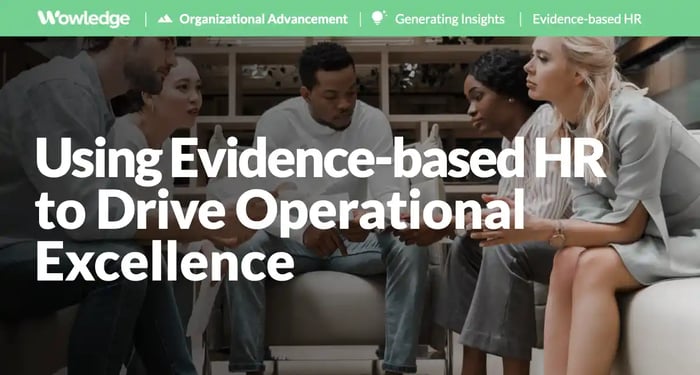Table of Contents
A great deal has been written, presented, dissected, and discussed about HR measurement and analytics over the years, with experts extolling their virtues, business value, and ability to enhance HR's credibility as a business function and partner. The objective insights they can bring to understanding workforce capabilities and trends, talent process efficiencies and effectiveness, and the impacts of HR programs are substantial. While offering the ability to provide a competitive edge to companies, many organizations continue to struggle with establishing the fundamentals required to bring that level of analytic capability. The problem begins at the most fundamental level of measurement and reporting: HR data quality and integrity.
LinkedIn research suggests that fewer than 25% (and as little as 8%) of companies can effectively utilize the data they have collected to produce even the most rudimentary insights into how their employees are deployed and managed. What this means is that as many as 92% of organizations cannot download and aggregate data from the myriad of automated systems they employ (at minimum an HRIS, LMS, ATS, TMS, and Payroll system) to generate meaningful metrics that can be presented on reports and dashboards to support proper talent oversight, management, and decision-making.
The challenges with producing analytics are uncomfortably commonplace, including problems with HR data integrity, quantitative and statistical skill shortages on HR teams, and poorly integrated systems. However, these issues start with HR data quality problems, where the adage “garbage in, garbage out” is sadly the rule rather than the exception. If inaccurate, incomplete, or improperly formatted data is input into a system, HR data quality is compromised, leading to inaccurate metrics, questionable analyses, and ultimately untrustworthy reporting. This creates a lack of faith in the HR team’s observations and recommendations, damaging the function’s credibility within the organization.
Defining HR data quality and integrity and their importance
There are two common concepts at work here that work together but are often conflated or confused: HR data quality and data integrity. Data quality refers to the accuracy, completeness, and relevance of data as it is collected and managed. In contrast, data integrity focuses on maintaining and ensuring that the data remains accurate, consistent, and reliable throughout its entire lifecycle, from creation to storage, processing, and retrieval.
Together, they represent a process and outcome designed to confirm and ensure the accuracy, completeness, and quality of data as it exists and is used over time and across applications. What appear to be simple concepts on the surface are rich in complexity, with numerous opportunities to create errors and omissions that, in the HR function, can lead to substantial problems. Data integrity practices help ensure HR data quality by tracking and verifying that data is accurate and consistent across its various uses and applications, particularly when integrated for use in calculations, analyses, reporting, and decision-making.
Consider the sensitivity of the data that HR collects, including personally identifiable information (PII), such as employee Social Security numbers, family status, dependent names, bank account information, performance ratings, engagement survey responses, system logins and passwords, and even medical claims. If an error is made in the entry, processing, or sharing (e.g., across integrated systems) of such information, that sensitive data might misrepresent them or the actions taken on their behalf. Even worse, it could end up in the wrong hands (e.g., an unauthorized coworker or hacker) due to the storage of an incorrect email address or phone number.
At their core, HR data quality and integrity are:
- Focused on maintaining the reliability and trustworthiness of data.
- A means to ensure that employee data remains accurate, complete, consistent, and valid.
- Involved in safeguarding data against loss, corruption, and unauthorized access.
- Essential elements of solid data management practices that ensure that data is a reliable source for reporting, analysis, and decision support.
Key elements of HR data quality and integrity
Gaining a complete understanding of the complexity of managing the quality and integrity of HR data starts with diving into its foundations, or the characteristics of highly trustworthy data—across its lifespan of collection, uploading, processing, aggregation (with other data elements or employees’ data), integration (transfer across systems), manipulation and calculation, analysis, and reporting. That alone represents a substantial amount of treatment and movement of a single data point (e.g., a date of hire, pay grade, organizational assignment, learning course completion). Those critical characteristics include the extent to which every data point about each employee is:
- Accurate or error-free (Spelling of name; SSN; employee ID).
- Complete or comprising of every piece of required information (month, day, and year of birth; first, last, and maiden names).
- Consistent across every employee (only as they apply by role or level or location - performance ratings; merit pay increases; benefit plan selections).
- Standardized data entered and transferred in the same database field format (termination date = mm/dd/yyyy).
- Timely as up to date and current as possible (e.g., daily) (calculated tenure; contributions towards FICA annual limit).
- Valid as reflective of actual reality (dependents’ names and ages; PTO days and hours accumulated).
- Unique with no duplicated data elsewhere in the systems (same email address in every system; same name and spelling).
When we add elements related to the broader concept of data integrity:
- Secure and protected from unauthorized access and modifications (e.g., single sign-on (SSO); encryption; two-factor (2FA) verification).
- Unaltered across its use and applications in storage, transmission, or reuse in blended metrics, analyses, and reporting.
The last point also clarifies that data quality and integrity involve not only the maintenance and assurance of raw data (e.g., the assigned content entered into each defined data field) but also when combined or used to enter data into automated or calculated fields. This is a crucial element to understand, as raw data fields are often combined to create others, such as the length of service/tenure (e.g., the current date minus the hire date), managers' average team engagement levels, or total sales commissions. Both types of data fields require auditing and evaluation for accuracy, as they can directly impact employee eligibility for benefits and assessments of performance or contributions.

The value of complete HR data quality and integrity
The benefits of high HR data quality are substantial and have a direct impact on business and talent processes, programs, and talent decisions. They can make or break leaders' and managers' confidence in the business alignment and savvy of HR leadership and team members, as well as perceptions and the level of trust in HR's observations, trends, and recommendations. The value of robust (and risks of poor) HR data quality and integrity oversight and management include:
Accurate information
Taking formal steps to ensure that the information used is accurate and reliable simplifies its use. It avoids unnecessary inefficiencies, lost time, staffing and resource costs, and poor responsiveness that result from the need to investigate and make corrections as errors and omissions are identified through manager or employee complaints, questions, and challenges. It enables reliable and consistent comparisons over time, across organizational units and circumstances, which can reveal the steadiness of improvements or outlier occurrences that require a “deeper dive” into the reasons for unusual or anomalous events.
Trust and confidence
When HR data is accurate and reliable, it builds trust in the information and the systems that manage it. Reporting based on data that reveals inconsistencies, inaccuracies, or results and trends that are difficult to explain dilutes the faith that leaders and managers have in HR and its recommendations. HR's credibility is supported by the consistency, reliability, and relevance of its reporting and resulting strategies and action plans.
Compliance
As organizations regularly comply with regulatory reporting requirements and many industries are subject to a wide range of specialized trends, occurrence, and impact reports, data integrity is an essential and ongoing requirement to ensure compliance. Data and reporting inconsistencies that arise from low HR data quality within or across multiple years pose a risk of negative findings, fines, and more extensive audits by governmental agencies. Such audits are costly and most frequently create an atmosphere of suspicion among regulators, leading to a thorough and painstaking search for violations and noncompliance based on a lack of trust in the organization’s data and report accuracy.
Quality business decisions
Reliable data is crucial for making informed business decisions and driving effective strategic initiatives. The purpose of reporting is to understand occurrences and trends, what is happening (and how and why), support decision-making, and track the improvements from initiatives and enhancements. Those uses and benefits can be hampered or even compromised if HR data is inaccurate, incomplete, or unreliable, thereby risking responses and solutions that are improperly based and have budgets and expectations for improved performance attached to them. This is perhaps the worst-case scenario, as inaccurate or incomplete data can yield only partially accurate pictures of a challenge, resulting in assumptions that are either worse than the actual situation or better than what is feared. In either case, time, effort, costs, and expectations are poorly placed.
Common reasons for low HR data quality
Many well-established, documented, and widely experienced causes contribute to HR data quality and integrity issues, all of which can be addressed through solid data management, system design and configuration, and adequate protection practices. Understanding these is important as it provides opportunities to address weaknesses in process and technology design.
- Human error. Employees, managers, administrators, HR shared services, and even IT and HRIS systems administrators can incorrectly enter data by transposing numbers, misspelling a name, entering a datapoint in an unauthorized format, or simply “fat-fingering” when entering or transcribing data into a field from a hard-copy document or note.
- Discrepancies in data formats. Data guidelines for input format (dd/mm/yyyy), values (alphanumeric, integer, $USD), and data type (forced choice, open text with digit limits) that are not enforced by the system or are stored across different systems or databases can lead to confusion and errors.
- Missing or incomplete data. Data fields that are left blank during entry or transfer can lead to issues with other calculated fields that rely on them, as well as reporting that excludes the employee’s data from subsequent analyses and reports.
- Cross-module or system inconsistencies. Data that is duplicated or redundant with other systems or modules creates a risk of differences in what should be identical information on each employee (e.g., given vs. nickname, married vs. birth name). This is a common occurrence when data is “siloed” in separate systems that have separate formats, standards, and even purposes.
- Data Sharing and transfer issues. Integrating data between HR and financial, operational, or business systems relies on standard employee identifiers, such as SSN, Employee ID, or name, which can differ and create issues when compiling them into reports or common databases, data lakes, or data marts. Data can also be digitally corrupted or misdirected during automated upload and update processes. The use of shared drives for collaboration and access to a common dataset also creates opportunities for individual users to inadvertently manipulate a spreadsheet or database, potentially overwriting or altering core data.
Any of these can lead to a series of subsequent problems for employees, managers, and the organization, and yet are manageable, even if not completely avoidable. The key to optimizing HR data quality is to understand how HR systems and their data repositories operate, how to define the structure of data for consistency, how user interfaces can be configured to reduce or eliminate errors at the point of data entry, and what to monitor.

Steps to maintaining HR data quality and integrity
1. Establish or participate in data governance
Data governance defines how an organization manages its data, including who has authority and control over those assets, as well as the policies, procedures, and standards in place for managing and protecting the data. To the extent that an IT or other function has created such a body of standards, practices, and accountabilities, alignment and compliance with these are essential.
2. Create and maintain a data dictionary
A formal data dictionary documents every piece of data collected, compiled, used, and managed within each HR system. It is a crucial tool to ensure the consistency of data fields within and across systems, documenting information related to each field’s definition, content format, size, source, and ownership.
3. Automate data capture
A powerful way to ensure HR data quality is to configure each HR system with standards that are managed and enforced automatically during data entry. The standards set in the data dictionary should be used to limit what can be entered or edited while typing content into the field. This is often accomplished by having fields that auto-populate based on other verified data about the user (e.g., name, job title and level, employee ID, business unit, location) or by limiting what can be entered by using drop-down forced choices (“select one of these options”).
4. Implement access control
Standard security features in HR systems are the access control and authorization capabilities, which define 1) who can access (log-into) a system, 2) who can view certain records and 3) what actions (e.g., view, enter, edit, approve) each individual can take based upon the level of authorization appropriate to their assigned role and responsibilities. (e.g., as a leader of all employees located in five work locations or a manager of 12 specified employees).
Much like the auto-population of a person’s data when entering data, this relies upon a table or other system functionality that governs each employee’s access to predefined information and system features and functions. When entering the system(s) to create new transactions, it preloads the latest data and offers entry and edit options to enable structured data collection wherever possible.
5. Establish data validation and verification processes
Implement checks and procedures to ensure that HR data quality meets predefined criteria and standards and is accurate. Assign team members from HRIS, HR Shared Services, or others knowledgeable with the data under review (e.g., L&D for LMS data, Recruiters for ATS data). The processes should be clearly defined with the representative sample size of records that will be reviewed, the frequency of those quality checks, a calendar or cadence for review cycles, the source documentation against which accuracy comparisons can be made, and the data dictionary version that will be used to ascertain compliance with data format standards.
6. Integrate data and manage it carefully
Maintain “source of truth” data sources (e.g., HRMS, Payroll, ATS, LMS, TMS) that are free from outside manipulation and disturbances. Create a data repository that integrates all available HR data and is regularly updated (e.g., nightly) and subject to consistent and structured reviews and audits. This becomes a robust and trusted source of data, designed to be accessed by authorized teams and users for analysis, generation of analytics, reporting, and tracking of historical trends. It also enables the maintenance of HR data quality within those individual systems (which are similarly monitored and audited) in a manner that significantly reduces the risk of data corruption and mishandling and creates redundancy that is critical to data management and integrity.
7. Adhere to information technology (IT) and cybersecurity standards
Working with internal IT and security teams, ensure that HR system expertise is developed and leveraged in the governance activities related to the process and oversight of critical technology activities and protocols including: data backup and recovery, data encryption, access monitoring and validation, data security, backups and recovery plans, data versioning and timestamps, and audit trails and logs. Issues that arise from these activities should be raised and discussed with HR leadership to ensure their awareness and necessary actions.
8. Train all users
Ensure that every employee with access rights receives training and updates on system and HR data quality and integrity procedures, as well as best practices. Raise awareness of how the system detects incorrect or improper data entry and guides users through corrections, including system-generated aids or pop-ups for fixes. Provide context for the need and value of accurate, complete, and consistent data collection for them and the larger organization.
Relevant Practices & Tools
Core HR Metrics and Reporting Practices to Establish a Robust HR Decision Support Capability. >
The structured measurement and presentation of employee and human resources process data provide quantitative insights to drive objective and educated decision-making... more »
The Data Dictionary Tool: Define Metric Names and their Attributes to Maintain Consistency of the Data's Format, Size, and Style. >
The data dictionary is a table that lists the details of each piece of data to be entered into an HR or related system, database, or spreadsheet and describes the precise format to be used... more »
Identifying and Calculating the Internal Supply of Available Talent. >
Understanding the current state of talent that is available and deployed across the enterprise is an essential part of workforce planning... more »
Measuring Process and Success Outcomes for both Career and Business Impacts. >
While career development involves a long lead time with job changes coming every one to three years at minimum, measurement is an essential element of assessing the ROI... more »
The Metrics Calculation Guide Tool: Lay Out Metrics and How they are Calculated to Build Consistency of Data's Inputs and Outputs. >
The metric calculation guide is a template that lists the details for each metric to be computed in an HR or related system, database, or spreadsheet and describes the precise method... more »
About Wowledge
Wowledge is the implementation-first platform designed for lean HR teams and consultants who need to design and scale strategic HR programs efficiently—without starting from scratch.
Our members gain access to continuously updated best practices, step-by-step guidance, expert-built tools, and customizable templates—all structured to accelerate the development and implementation of key HR programs.
Recognizing that every organization operates at different levels of sophistication, Wowledge’s scalable system of best practices follows a stage-based approach—Core, Advanced, and Emerging—ensuring HR professionals can implement solutions tailored to their organization’s unique needs and goals.
Your Shortcut to Amplifying HR Impact!
Get started for FREE! Learn more.










